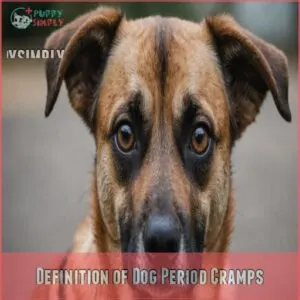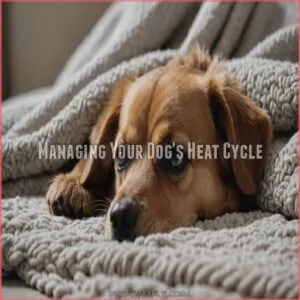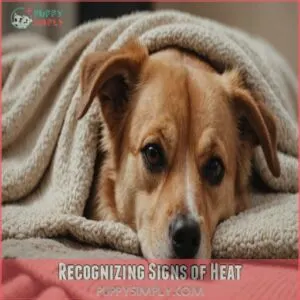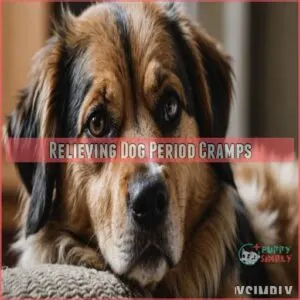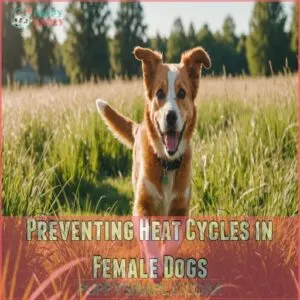This site is supported by our readers. We may earn a commission, at no cost to you, if you purchase through links.
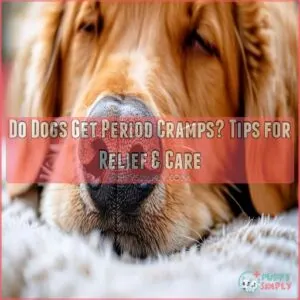 Wondering if dogs get period cramps?
Wondering if dogs get period cramps?
While they don’t experience cramps like humans, female dogs can feel some discomfort during their heat cycles.
You might notice subtle signs like trembling or a slight change in posture, indicating they’re feeling a bit out of sorts.
Although there’s no scientific evidence of actual cramps, these changes are due to hormonal shifts as their bodies prepare for possible motherhood.
So, offering a soft blanket and maybe a gentle massage can go a long way.
Think of it as their way of asking for a little TLC.
Curious about more ways to help her?
Table Of Contents
- Key Takeaways
- Definition of Dog Period Cramps
- Do Dogs Experience Pain During Their Cycle
- Managing Your Dog’s Heat Cycle
- Recognizing Signs of Heat
- Stages of The Heat Cycle
- Relieving Dog Period Cramps
- Can Dogs Get Pregnant During Their Cycle
- Preventing Heat Cycles in Female Dogs
- Providing Emotional Support for Your Dog
- Managing Discharge During Heat Cycles
- Frequently Asked Questions (FAQs)
- Do dogs have period cramps?
- What are the causes of period cramps?
- Can dog period cramps be cured?
- Can dogs get period symptoms?
- How can I Help my Dog with menstrual cramps?
- Can I give my Dog a pain killer for menstrual cramps?
- Do female dogs feel pain during their period?
- How can I ease my dog’s period pain?
- How do I comfort my dog during her period?
- Can dogs cry from cramps?
- How can diet affect dogs during heat?
- What exercises are suitable for dogs in heat?
- Can stress impact a dogs heat cycle?
- How often should a dog be groomed during heat?
- Are there alternative therapies for dog period discomfort?
- Conclusion
Key Takeaways
- Female dogs don’t experience period cramps like humans, but they can feel some discomfort due to hormonal changes during their heat cycle.
- You might notice behavior changes such as trembling, restlessness, or changes in appetite; offering comfort like gentle massages or extra cuddles can help.
- Dogs can get pregnant during their heat cycle, so it’s important to keep them supervised to prevent unwanted mating.
- Spaying is the most effective method for preventing heat cycles and related issues, but discuss the pros and cons with your vet to decide what’s best for your dog.
Definition of Dog Period Cramps
When your dog is in heat, she might experience some discomfort, similar to how you might feel during your period.
These cramps aren’t painful like a bad day at the gym class, but you may notice her trembling, losing her appetite, or arching her back.
Physical Discomfort During Heat Cycles
Imagine your dog’s heat cycle as a roller coaster ride of feelings and behavior changes.
During her heat cycle, she mightn’t experience human-like cramps but could feel dog discomfort during the heat cycle.
Signs like pacing, excessive grooming, and lack of appetite pop up.
For more information on managing these symptoms, consider exploring products related to Dog period symptoms.
Offering support with heat cycle care, such as extra cuddles or gentle massages, can ease her discomfort.
Hormonal Changes and Cramps Preparing The Dog’s Body
So, your dog’s experiencing discomfort during her heat cycle?
It’s all about those hormonal fluctuations.
Think of it like this: her body’s gearing up for potential pregnancy.
Hormonal changes trigger uterine contractions, leading to muscle tension and changes in blood flow.
This can cause some mild discomfort, similar to menstrual cramps in humans, though not as intense.
A dog’s heat cycle, which can last around three weeks, is a normal part of the canine menstrual cycle.
You’ll see changes in vaginal discharge, too.
Don’t worry, it’s usually temporary.
Symptoms Like Trembling, Lack of Appetite, and Arched Back
Your furry friend might show signs of discomfort during her heat cycle, like trembling, a lack of appetite, or arching her back.
These symptoms hint at dog heat discomfort, and while they can’t complain like we do, their body language speaks volumes.
Offer back pain relief with cozy beds and gentle massages.
Keep her happy with yummy treats and emotional support to ease her canine heat.
Do Dogs Experience Pain During Their Cycle
You might wonder if your dog feels pain during her heat cycle, but there’s no scientific proof that she experiences anything like human period cramps.
While she could be a bit uncomfortable, it’s usually not agonizing, so just keep an eye out for any signs of extreme distress.
No Scientific Evidence to Suggest Pain During Estrus
Many people wonder if dogs suffer pain during their heat cycles, but there’s no scientific evidence to suggest they do.
While estrus discomfort can be noticeable, it’s more manageable than painful.
We’ve all seen how hormonal changes can make dogs a bit stressed.
Keeping them comfortable helps manage any dog stress, making the period cramp myth just that—a myth.
Discomfort, Not Agonizing Pain, During The Heat Cycle
While there’s no scientific evidence that dogs experience significant pain during estrus, they do face some discomfort during their heat cycle.
Think of it as feeling a bit out of sorts.
You might notice your dog’s behavior changes slightly—maybe she’s licking more or seems a bit restless.
Providing extra heat cycle comfort and understanding heat cycles helps soothe your dog effectively.
Monitoring for Extreme Pain Symptoms
Spotting extreme pain signs in your dog during her cycle can be challenging.
Keep an eye out for:
- Unusual behavior: If she’s more irritable or lethargic, a vet visit might be needed.
- Appetite changes: Refusing food can signal discomfort.
- Medication concerns: Avoid giving human meds.
- Constant whining or trembling: Could be a warning sign.
These actions help her stay comfortable and healthy.
Managing Your Dog’s Heat Cycle
Managing your dog’s heat cycle is all about preparation and giving her the space she needs, which might feel a bit like hosting a guest who insists on wearing a tutu and doesn’t want any male dogs crashing the party.
Keep a watchful eye to prevent unwanted mating while understanding the risk of pregnancy, all while being her emotional support buddy through this time.
Prepare for Bleeding and Give Her Space
So, your doggo mightn’t have cramps, but she’ll definitely bleed during her heat cycle.
Prepare for this by using doggy diapers – think of them as her period panties, and you can find more products to help with Dog Period Pain Relief online.
Giving her some space and privacy is also key.
| Item | Pros | Cons |
|---|---|---|
| Doggy Diapers (Reusable) | Eco-friendly, cost-effective | Requires washing |
| Doggy Diapers (Disposable) | Convenient, readily available | More expensive, creates more waste |
| Designated Area | Simple, low-cost | May require more frequent cleaning |
| Quiet, Calm Environment | Reduces stress, promotes relaxation | Mightn’t be suitable for all dogs |
Keep Her Contained and Supervised to Prevent Unwanted Mating
Your furry friend’s heat cycle can be like facing a series of doggy dating dilemmas.
Keep her contained and supervised to avoid any romantic escapades, ensuring heat cycle safety and responsible breeding.
Understanding the dog heat cycle duration is important to prevent accidental mating, as it typically occurs every six months.
Supervise her outdoor time and use secure spaces to manage the dog estrus cycle and keep those surprise puppies at bay!
Understand Pregnancy Risk and Provide Emotional Support
Every dog owner dreads the unexpected pregnancy, right?
Understanding the pregnancy risk during your dog’s heat cycle is essential.
Keep a close eye on her behavior to prevent any surprise bundles of fur.
Offering emotional support is key; your dog needs comfort, especially with the hormonal changes she’s going through.
Spend extra time cuddling and soothing her to strengthen your emotional bond.
Recognizing Signs of Heat
When your dog is in heat, you’ll notice some clear signs like increased urination, a little bloody discharge, and a swollen vulva.
These changes can be surprising, but don’t worry—your pup might just be extra nervous and suddenly more interested in meeting male dogs, making it an interesting time for both of you!
Increased Urination and Bloody Vaginal Discharge
While managing your dog’s heat cycle, you’ll notice increased urination and bloody vaginal discharge.
This normal discharge signals she’s in her heat cycle, not unlike a teenager’s growing pains.
For effective management, consider investing in Dog Period Essentials.
To manage this, using dog diapers can be a lifesaver, keeping your home clean and ensuring your pup’s hygiene.
Just like teenagers, your furry friend might get whiny, needing a bit more attention.
Swollen Vulva and Behavioral Changes
Noticing your dog’s swollen vulva during her heat cycle? It’s a clear sign she’s in heat, much like the tell-tale pink of a ripe watermelon.
These changes in normal vulva size come with behavioral shifts too.
Expect variations with breed differences, and watch for discharge color changes.
Remember, heat cycle variations are natural, and your furry friend might just act a bit differently during this time.
Nervousness, Distraction, and Receptiveness to Male Dogs
You’ve noticed your dog’s swollen vulva and behavior shifts. Get ready for the whirlwind of emotions! She might be more nervous or distracted, ready to mingle with male dogs due to hormonal changes.
Keep a lookout:
- Increased curiosity about male dog behavior.
- Signs of heat cycle stress.
- Mating instincts kicking in.
- Owner anxiety, wondering what’s next.
Stages of The Heat Cycle
Your dog’s heat cycle has four stages: proestrus, estrus, diestrus, and anestrus.
Understanding these stages will help you better support your furry friend during this time, so let’s explore each one!
Proestrus: 6-11 Days
During the proestrus phase, which lasts 6-11 days, you might notice your dog’s mood shifting as a result of proestrus behavior changes.
Her vulva swells, and there’s proestrus bleeding.
Consider using dog diapers—reusable or disposable—to manage the mess.
These changes are normal, so no need to stress!
Just offer a cozy spot and lots of attention.
Estrus: 5-9 Days
Estrus, lasting 5-9 days, is when your dog’s fertility peaks.
Ovulation occurs, and she’s fully receptive to mating, marked by clear or straw-colored vaginal discharge.
You might notice some behavioral changes, like increased friendliness or agitation.
Keep an eye on her interactions to prevent unwanted pregnancies.
No need for dog pain medication here, but extra attention helps.
Diestrus: 5-9 Weeks
After the whirlwind of estrus, welcome to the Diestrus stage, which stretches over 5-9 weeks.
Here’s where your dog winds down, but don’t let that fool you into thinking it’s all quiet.
During this post-ovulation period:
- High progesterone: Keeps things stable.
- Possible Discharge: Normal, but keep an eye on it.
- Behavioral Changes: A bit of restlessness or clinginess.
Enjoy downtime with cozy dog massages and soothing music.
Anestrus: 4 Months
Wrapping up diestrus, and you’re in the calm of anestrus, lasting four months.
Think of it as a dog’s snooze button, preparing for the next cycle.
There’s little drama in this phase—just low hormones and body reset.
Meanwhile, check this out:
| Aspect | Description |
|---|---|
| Phase Length | 4 months |
| Hormones | Stable and low |
| Behavior | Relaxed and calm |
| Health Focus | Rest and recovery |
| Human Role | Monitor and maintain well-being |
Relieving Dog Period Cramps
When your furry friend seems a bit uncomfortable during her heat cycle, offering comfort can make all the difference.
Use a heating pad or gentle massages to help her relax, and don’t forget a bit of playtime to keep her spirits high—because even dogs need a little distraction!
Providing a Heating Pad or Hot Water Bottle
Understanding your dog’s discomfort during heat cycles can feel overwhelming.
Did you know a simple heating pad or a hot water bottle can work wonders?
By offering gentle warmth, you help soothe cramps and provide stress relief.
Here’s how:
- Set the heating pad to a comfortable temperature.
- Place it gently under your dog’s belly.
- Always monitor to make sure safe use.
Offering Gentle Massages and Emotional Support
Gentle belly rubs can soothe your pup.
Focus on areas she seems to favor.
A calm touch helps reduce stress.
Remember, a little extra love goes a long way during this time.
Your comforting presence offers significant stress relief.
Pay attention to her body language; if she pulls away, stop.
These dog massage techniques, combined with soothing words, strengthen your bond.
It’s a win-win: comfort for her, bonding for you!
This is part of managing discomfort during heat cycles and relieving it.
Engaging in Playtime and Walks to Distract and Bond
After soothing your dog with gentle massages, it’s time to get moving.
Engaging in playtime and walks offers not just physical exercise but also mental stimulation, which can distract your pup from discomfort during heat cycles.
Some dog breeds like Jack Russell Terriers, known for their high energy levels and need for daily exercise routines, are perfect for this type of activity.
Think of it as bonding time; a chance to strengthen your relationship.
Remember, safety first on walks—keep an eye on hormones and other dogs!
Can Dogs Get Pregnant During Their Cycle
Yes, dogs can get pregnant during their cycle, especially when they’re in the estrus stage, which is when they’re most fertile.
So, if you want to avoid a surprise litter of puppies, it’s important to keep a close eye on your furry friend and prevent any unexpected romantic encounters during this time.
Understanding Pregnancy Risk and Preventing Unwanted Mating
While helping your furry friend through cramps, let’s talk about pregnancy risk during her heat cycle.
Did you know a dog can get pregnant almost anytime during this cycle?
Here’s why understanding heat cycle facts is key.
For peak fertility—around 9-10 days in—you’ll want to keep an eye on her.
Spaying, which involves surgically removing a dog’s ovaries and uterus prevents heat cycles, is an effective way to eliminate the risk of unwanted mating.
Preventing mating isn’t just about timing; it takes constant vigilance.
Think of ways to manage your dog’s heat cycle effectively, like using doggy diapers and keeping her supervised.
Plus, spaying offers great benefits, reducing the risk of mammary, uterine, and ovarian cancers and keeping things simple.
Signs of Pregnancy and Caring for a Pregnant Dog
You’ve got a furry mom-to-be on your hands! Look for nesting behavior, like rearranging blankets and toys. Weight gain is another sign she’s expecting.
Be sure you’re feeding her enough to meet her changing dietary needs. Think of it like preparing a tiny buffet for puppies-to-be! Puppy preparation is key—set up a comfy birthing area ahead of time.
The birthing process might sound scary, but trust your instincts and keep your vet’s number handy. Remember, each dog is unique—some cruise through pregnancy, while others need a bit more TLC. Keep watch and offer plenty of love!
Preventing Heat Cycles in Female Dogs
If you’re hoping to prevent your female dog from going into heat, spaying is your best bet, offering both peace of mind and fewer puppy surprises.
For those who aren’t quite ready to commit to spaying, there are alternatives like hormone injections, though they come with their own set of considerations.
Getting Your Female Dog Spayed
Spaying your female dog is a great way to prevent those pesky heat cycles.
It’s like flipping a switch on the hormonal rollercoaster, easing discomfort during heat cycles.
Consider talking to your vet about the right spaying age and recovery time.
Vets often highlight benefits like avoiding symptoms such as trembling or appetite loss.
Let’s face it, spaying simplifies life for both you and your furry friend!
Understanding The Risks and Benefits of Spaying
Considering spaying? It’s a big decision!
Spaying prevents unwanted pregnancies, greatly reducing the risk of mammary cancer if done before the first heat.
However, it’s not without potential downsides.
Some studies suggest a slightly increased risk of certain cancers later in life, depending on the breed.
Discuss the pros and cons with your vet; they can help you decide what’s best for your dog, considering her breed, age, and overall health.
Factors like spay cost comparison and spay surgery recovery should also be considered.
Remember, the best spay age recommendation depends on your dog’s individual needs.
Alternatives to Spaying for Managing Heat Cycles
Juggling your dog’s heat cycle without spaying might feel like walking a tightrope, and some owners may also consider the potential impact of spaying on behavior, such as strange behavior after spay. Fortunately, Hormone Injections and Progesterone Supplements offer some relief.
If synthetic options aren’t your cup of tea, you can try Natural Remedies, like herbal treatments.
Dog Diapers ease the mess during heat cycles, ensuring your furniture stays spotless.
- Ease her discomfort with progesterone and hormone aids.
- Try natural routes for a gentle touch.
- Protect furniture with cozy dog diapers.
Providing Emotional Support for Your Dog
Providing emotional support for your dog during her heat cycle can make a world of difference, even if you can’t explain why she’s suddenly not in the mood to fetch.
Offer plenty of affection, try giving her some chew toys for distraction, and don’t underestimate the soothing power of calming music for a cozy, chill-out vibe.
Showing Affection and Emotional Support
Cuddling up with your furry friend during her heat cycle can work wonders for relieving anxiety.
Dogs thrive on affection, so a little extra belly rub or ear scratch goes a long way.
You might find that her comfort is contagious!
Listening to your dog’s needs and adjusting your attention can make both of you feel closer, enhancing the comforting bond you share.
Offering Chew Toys and Treat-Stuffed Toys for Mental Stimulation
Your pup’s heat cycle can bring discomfort, but offering chew toys and treat-stuffed toys helps ease their stress.
These toys provide mental stimulation, turning your dog’s focus away from hormonal changes.
It’s like giving them a playful puzzle to solve.
As they gnaw and nibble, they forget their cramps.
Consider this a fantastic way to relieve dog boredom during those tricky heat cycles.
Playing Calming Music to Create a Relaxing Atmosphere
While the dog world mightn’t host Grammy Awards, playing calming music can surprisingly help reduce stress.
Consider picking tunes like soft rock or reggae that might ease your pup’s mood.
Watch your dog’s reaction—they might enjoy a woof-worthy concert!
Music preferences can vary, but many dogs benefit from the rhythm.
It’s like dog acupuncture for their soul, offering a peaceful, zen-like atmosphere.
Managing Discharge During Heat Cycles
Managing your dog’s discharge during heat can feel like a messy business, but reusable or disposable dog diapers are your best buddies.
Keep your dog contained and give her a comfy space, and you’ll both get through this with minimal fuss—though extra belly rubs never hurt!
Using Reusable or Disposable Dog Diapers
Now that you’ve showered your pup with love, let’s talk about managing that messy period.
Diaper types include reusable and disposable options.
Reusable diapers are eco-friendly and can save you money in the long run, but they require washing.
Disposable diapers are super convenient, but they’re more expensive.
Consider diaper fit to prevent leaks.
Proper diaper care is important regardless of your choice.
A good fit minimizes leaks and keeps your dog comfortable.
Finding the right balance between cost and convenience is key to managing your dog’s heat cycle effectively.
Remember, a happy pup is a healthy pup!
Preparing for Bleeding and Giving Your Dog Space
Switching from reusable to disposable dog diapers? While that’s smart, prepping for bleeding means more than just a wardrobe change.
Make sure to create cozy spaces for your pup, perhaps a comfy crate or bed, to relax away from foot traffic.
Remember, everyone needs a little space sometimes, especially during the heat cycle prep.
A clean area helps keep those furry feelings light-hearted!
Keeping Your Dog Contained and Supervised
Managing discharge is one thing; keeping your spirited canine contained and supervised is another.
Let’s make this simpler. Think about these options:
- Doggy daycare: Perfect for when she’s home alone and you’re at work.
- Fenced yard: Provides freedom to roam safely.
- Leash walks: Offers control during Signs of a Dog in Heat.
These tricks help manage your dog’s heat cycle effectively.
Frequently Asked Questions (FAQs)
Do dogs have period cramps?
Dogs don’t get period cramps like humans, but they can feel a bit uncomfortable during their heat cycle.
You might see your furry friend restless or off their feed.
Offer extra cuddles and gentle walks for comfort.
What are the causes of period cramps?
Your period cramps happen because your uterus contracts to shed its lining.
Hormonal changes and prostaglandins, chemicals that cause muscle contractions, are the main culprits.
It’s your body’s way of saying, "Time for a fresh start!
Can dog period cramps be cured?
Calm canine cramps can’t be completely cured, but you can comfort your pup with cozy blankets and belly rubs.
Many dogs handle these hiccups with ease.
A vet visit can help if discomfort disturbs daily doings too much.
Can dogs get period symptoms?
Female dogs experience signs similar to period symptoms during their heat cycle. During this time, they may undergo physical changes, such as bloody discharge and vulva swelling, which can be uncomfortable. Female dogs experience signs similar to period symptoms during their heat cycle.
They might display behavioral changes, like nervousness and distraction, increased urination, and physical symptoms, including a swollen vulva and discharge—like a dog’s version of puberty drama!
How can I Help my Dog with menstrual cramps?
Help your dog with menstrual cramps by offering gentle belly massages.
Gentle belly massages can help ease her discomfort.
Using a warm heating pad can also provide relief.
Favorite chew toys can help distract her.
A soothing voice and extra cuddles can also ease her discomfort and make her feel loved.
Can I give my Dog a pain killer for menstrual cramps?
Before giving your dog a pain killer for menstrual cramps, consult your vet for advice.
Human medications can be harmful to dogs, so it’s very important to get professional guidance for safe and effective alternatives.
Do female dogs feel pain during their period?
Yes, dogs can feel some discomfort during their heat cycle.
They mightn’t experience severe pain, but you’ll notice behaviors like extra grooming or restlessness.
Offering comfort and gentle care can really help your furry friend feel better.
How can I ease my dog’s period pain?
To ease your dog’s period pain, try using a warm heating pad on her belly, offer gentle massages, and provide chew toys for distraction.
Distraction can help your dog cope with the discomfort.
Keep her cozy, spend extra time with her, and speak soothingly.
How do I comfort my dog during her period?
Think of it like a human’s period; it’s a hormonal rollercoaster.
Give her extra cuddles, gentle belly rubs, and maybe a comfy bed.
Distraction is key – playtime helps!
If she seems really down, chat with your vet.
Can dogs cry from cramps?
Dogs don’t cry like humans, but they can whine or show discomfort during their heat cycle.
While there’s no evidence of severe pain, your pup might feel uneasy.
Offering comfort, gentle massages, and toys helps.
How can diet affect dogs during heat?
Diet can greatly impact dogs during heat.
High-quality protein supports energy needs, while fiber aids digestion.
Always provide fresh water.
Offer small, frequent meals for comfort, and avoid sudden diet changes to prevent stomach upset.
What exercises are suitable for dogs in heat?
When life’s little red signals come calling, gentle walks, brain games, and light fetch offer great exercise for dogs in heat.
Avoid overly vigorous play to keep them comfy and content, while maintaining their well-being.
Can stress impact a dogs heat cycle?
You might be surprised, but stress can indeed impact a dog’s heat cycle.
Just like people, dogs can experience shifts in their cycle due to anxiety or changes in their environment.
Keeping routines helps.
How often should a dog be groomed during heat?
Keep your dog fresh during heat by grooming weekly, focusing on the back end.
This helps manage cleanliness and comfort.
Use gentle brushes and wipes to prevent irritation.
A little extra pampering never hurt anyone, right?
Are there alternative therapies for dog period discomfort?
A watched pot never boils, but your pup’s heat discomfort can simmer down with acupuncture or calming music.
These therapies promote relaxation and release endorphins, offering gentle relief.
Always consult your vet before trying new techniques.
Conclusion
Ultimately, while dogs don’t experience period cramps in the human sense, they do undergo hormonal shifts during their heat cycles that can cause discomfort.
Remember, understanding your dog’s heat cycle is key. You’ll learn to recognize signs of discomfort, like trembling or changes in appetite. Providing comfort, like a soft bed or gentle petting, can make a big difference.
So, while they don’t get period cramps, managing their heat cycle with care and attention is essential. Knowing the signs and offering support shows you care for your furry friend. Remember, a little TLC goes a long way in easing any discomfort related to do dogs get period cramps.

